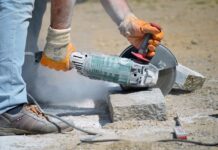rototypes for President Donald Trump’s border wall may be completed by the end of October.
After months of delay, the Department of Homeland Security announced Thursday that it had selected four vendors to build prototypes of their proposed concrete walls in the San Diego area. Up to four selected proposals for alternative building materials will be announced later.
None of the finalists are San Diego-based. Caddell Construction Co. of Montgomery, Alabama, Fisher Sand & Gravel Co. of Tempe, Arizona, Texas Sterling Construction Co., of Houston and W. G. Yates & Sons Construction Company of Philadelphia, Mississippi were chosen. They were awarded between just under $400,000 and about $500,000 each.
The prototypes will be built near the Otay Mesa port of entry. They will be 30 feet long and up to 30 feet high.
U.S. Customs and Border Protection acting deputy commissioner Ronald Vitiello said he expected construction to begin in a couple of weeks, and companies will have 30 days to complete their projects.
Once they are finished, border experts will test the walls for aesthetics, anti-climbing features, resistance to tampering and penetrability with small hand tools.
Contractors are also required to account for other technological features, like sensors, cameras and lighting, that would accompany the physical walls.
“There’s a more holistic view here,” Vitiello said. “This is a much safer environment than what we’ve planned for before.”
After testing, Border Patrol may choose to leave the structures in place, move them or get rid of them, Vitiello said.
Contractors will be responsible for providing their own security, according to Joshua Wilson, spokesman for the San Diego chapter of the National Border Patrol Council.
Because they will be building so close to the border, Wilson said, Border Patrol will also be monitoring the area.
“There has been a lot of planning that’s gone into this,” Wilson said, adding that he couldn’t go into specifics. “All the appropriate measures are being taken.”
For residents who live near the construction site, Wilson said he would expect increased traffic in the area though he did not know of any scheduled road closures.
“We’re looking forward to the construction of an improved physical barrier, and we’re quite interested to see what kind of innovation private industry is going to bring to the process,” Wilson said. “It’s going to mean increased border security and enhanced public safety.”
Prototype construction was initially scheduled for June but was pushed back to November after two companies questioned their exclusion from a list of finalists. The last of those protests were dismissed on Friday by the federal agency responsible for reviewing them.
The prototype project could still face further delays. Companies that believe they were wrongfully left out of the running will have another chance to protest, which would put an additional pause on construction.
Arizona-based environmental advocacy group, the Center for Biological Diversity, has already filed a lawsuit over the planned prototypes and wall extensions. Since former Homeland Security Secretary John Kelly implemented a waiver to avoid delays caused by required environmental reviews, the center has been working on an amendment to its case to challenge the waiver in court.
A hearing for the case is scheduled in mid-December, but given the construction timeline, Brian Segee, a senior attorney working on the case, said that the center will ask a judge to block construction until the case is decided.
The group is concerned about several endangered species that would be affected by prototype and actual wall construction, including the checkerspot butterfly, coastal California gnatcatcher and San Diego fairy shrimp.
The butterfly can’t fly very high, Segee said, so even though it has wings, walls meeting the project’s height requirements would cut it off from migration to Baja.
That’s not the only environmental danger, Segee said. Much of the existing border barriers were built using similar waivers that skirted environmental review.
“The government went forward blindly with construction and has largely kept the blindfold on after construction,” Segee said . “That’s a byproduct of lawless border wall building. We know much less than we should about the impacts of the existing wall.”
Some, including Christian Ramirez, director of the Southern Border Communities Coalition, criticized the administration for making the announcement so soon after the devastation of Hurricane Harvey. He also thought that other border issues, like sewage in the Tijuana river, would be a better use of the funding.
Ramirez, who is against building a border wall, was skeptical that, with acting heads of the Department of Homeland Security and Customs and Border Protection, the Trump administration would be able to meet the timeline outlined with the announced contracts.





